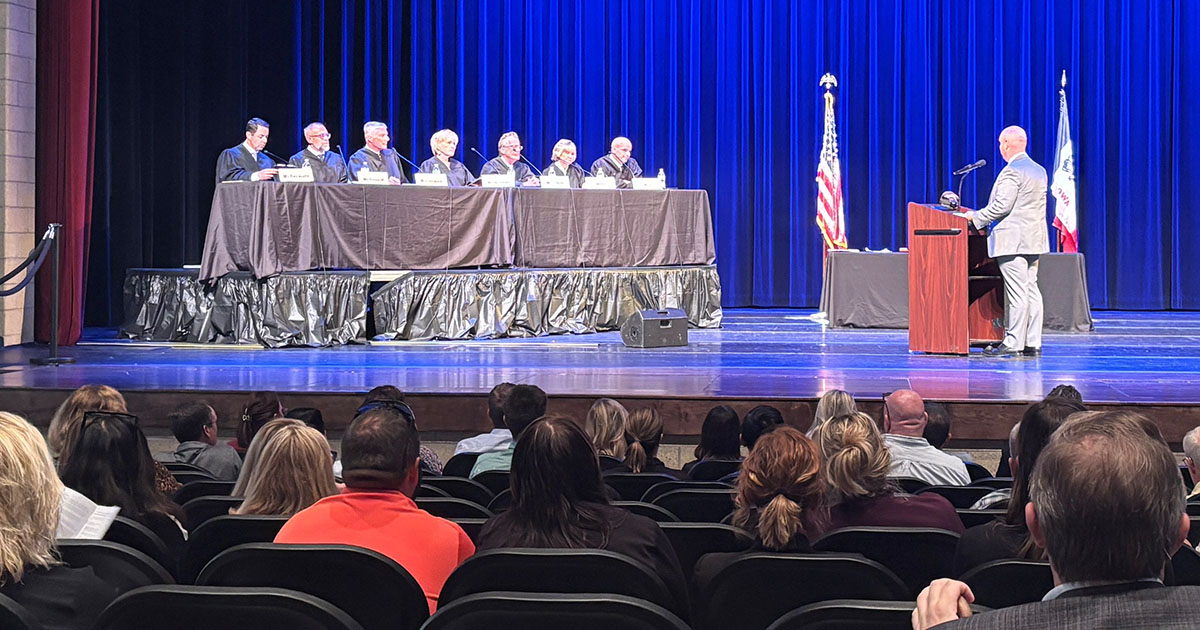
The Iowa Supreme Court recently heard a case at an Iowa high school. Photo: Trent Kubasiak.
I am a State Bar of Wisconsin nonresident attorney, and I recently found myself in the auditorium of my daughter’s high school, watching the Iowa Supreme Court hear live oral arguments in a pending case.
The justices sat on a temporary bench on the stage. Students, teachers and community members filled the seats. The case involved statutory interpretation, but the real lesson that evening was about the role of courts in public life.
The event was part of Iowa’s Constitution Day program, an annual tradition in which the state’s highest court travels to schools and community venues to hold arguments outside Des Moines. The official program was polished and educational. Students received summaries of the case. The proceedings were livestreamed for those who could not attend.
 Trent A. Kubasiak, Marquette 2013, is a JAG Corps attorney with U.S. Army, Rock Island Arsenal, Illinois, and lives with his family just across the Mississippi River in Iowa. He is a current member of the NRLD Board.
Trent A. Kubasiak, Marquette 2013, is a JAG Corps attorney with U.S. Army, Rock Island Arsenal, Illinois, and lives with his family just across the Mississippi River in Iowa. He is a current member of the NRLD Board.
Why this Court is On the Road
What stayed with me, however, was what happened after the arguments ended.
In a question‑and‑answer session with the audience, Chief Justice Susan Christensen explained why the court began taking its work on the road. She recalled the aftermath of the court’s 2009 decision recognizing same‑sex marriage rights. The ruling ignited a political backlash that led to three justices losing their seats in retention elections. In the years that followed, the court resolved to meet the public where they live, to show that justices are not abstractions in robes but people doing a job, bound by law and oath.
What struck me was the straightforwardness of the answer. It reflected something most of us in the profession already know, even if it is not often said outright: courts are part of the broader civic landscape, and the public’s trust in them is not automatic. That trust grows when people can see and understand the work being done.
The Importance of Building Bridges
In Wisconsin, our own Supreme Court has been the subject of intense political attention in recent years. Judicial races have drawn unprecedented spending and national headlines. Campaigns have been fought over issues that may come before the court, raising questions about the line between judicial independence and political reality. The result is a climate in which many citizens view the court through a partisan lens, regardless of the merits of its decisions.
Iowa’s approach is not a cure‑all. No single program can insulate a court from political pressures. But there is value in the simple act of showing up. When students see justices ask questions, listen carefully, and deliberate respectfully, they witness a process that is more complex than a headline or a campaign ad. When community members can speak directly to the people who interpret the law, they are reminded that the judiciary is part of their government, not apart from it.
As a practicing attorney, I have seen that much of the judiciary’s work is quiet and unseen. Cases are shaped in conference rooms and chambers, in the careful reading of briefs, the weighing of precedent, and the disciplined application of law to fact. From the advocate’s table, it is clear that the process is deliberate and exacting. Yet the legitimacy of that work depends on public understanding. If the public sees only the outcomes, and never the process that produces them, trust inevitably erodes.
Perhaps Wisconsin could consider more frequent forays beyond Madison. Not as a political gesture, but as a civic one. The courtroom can be a classroom. The bench can be a bridge.
And in a time when the judiciary is often drawn into the political fray, those bridges may be more important than ever.
This article was originally published on the State Bar of Wisconsin’s Nonresident Lawyers Blog. Visit the State Bar Divisions page or the Nonresident Lawyers Division webpage to learn more about division membership.
